S.J. Pajonas's Blog, page 163
October 8, 2013
Please Find My Motivation

A beautiful Fall day.
I’m treading water. Everyday, I’m working hard yet I’m not really going anywhere. Not a day goes by when I’m not working on Book 2, not reading a friend or crit partner’s manuscript, not promoting REMOVED or working on other things for it like a book trailer and researching blog tours. Just this week I was turned down by two blog tour hosts, and while I totally understand why they decided not to work with me, it still did nothing for my motivation. I realize that my book is in a niche. It’s different, but honestly, it’s not that different than ANY OTHER Young Adult dystopian on the market right now. Just look at the reviews. I’m getting 4 and 5 stars on Amazon and Goodreads.
Anyway, with the leaves falling from the trees and cool weather settling in, I feel like life is slowing down. I’m having trouble staying on top of things including the posts I have planned for this blog. I have a few half-written, and I need to just get in and finish them. Once those are out of the way, I’ll be promoting Book 2. I have a cover reveal planned for October 22! It will have a blurb and everything, and I’ll get it up on Goodreads right away. I just need to summon the energy to get it going.
If you find my motivation, please send it back to me. I miss it.
October 2, 2013
The Three Rs and Rewarding First-readers
As you know, for the time being, I am a self-publisher. I publish my own books. I am an author-publisher. But I’m more than that. I am a graphic designer, paperback layout designer, web designer and coder, marketer, and market analyst. When I decided to publish my books, I had to set aside a fairly huge chunk of change to launch this ship and keep it running. For those who are wondering, I have spent about $1000 of my own money to get these books into the hands of readers.
Yes. $1000. This budget includes: ads on Facebook and Goodreads, paperback versions of my books I give away, ISBNs, stock photography, goodies that I bought for the Japanese bento box giveaway, and many other things. Many of you know that I did not hire an editor or anyone else to do the majority of my work, and I still feel like I did a damned good job of producing a stellar book through the feedback of my beta readers and proofreaders. I had help along the way, for which I’m very grateful, but I knew I would have to invest in my self-publishing in order to get somewhere.

A box full of my own books. For me, for you, for giveaways.
The good news is that the $1000 that I spent will last the majority of this Nogiku Series and onward if I decide to keep self-publishing. The ISBNs were the most expensive investment, and I did spend a lot on stock photography which will also span the length of all my books (I have a year to download 100 photos. It should be enough.)
Let’s talk pricing. For my very first book, I knew the majority of people who would buy it were going to be my family and friends. These people have been my support (I love them so much) and many would pay the same rate for my books as they would for a traditionally published book. So, I priced my book just below traditional publishers at $10.99 for the paperback and $3.99 for the Kindle version. It’s lower now. Amazon dropped the price of the paperback for a short time and the price of the Kindle version to $2.99.
The numbers:
I make $2.10 on each paperback (Right now. That changes to less when I choose Extended Distribution.)
I make $2.58 on each $3.99 Kindle book if it’s bought via the US Amazon site.
If you think I sold hundreds of copies, please go for a walk and come to your senses. I did not, but that’s not the point. My sales were good the first week, and now only a few trickle in each week. I expected this. I actually don’t expect to see any surge in sales until more of my books are published, and that’s fine. I’m not in this for the money. I’m in it to get my books into the hands of readers. It would be nice to break even though, honestly. Breaking even would be fantastic! I earned enough royalties the first few weeks to offset 15% of my original pay-out. Not bad. I consider that a win.
But from now on, I’m going to be trying something different. I’m going to reward first-readers of my books by coming out on release day with a 99¢ price tag for the first two weeks and then settling on $2.99 thereafter. Sales will happen in anticipation of new releases or because I want to  But otherwise this will be the pricing structure I stick with for Nogiku and possibly beyond. I’ll be doing some flash giveaways on Facebook in the coming weeks for eBooks of REMOVED and a reviewer appreciation giveaway later in the year. There will always be something going on for first and new readers alike.
But otherwise this will be the pricing structure I stick with for Nogiku and possibly beyond. I’ll be doing some flash giveaways on Facebook in the coming weeks for eBooks of REMOVED and a reviewer appreciation giveaway later in the year. There will always be something going on for first and new readers alike.
By being a first-reader of my books, you snap up a good deal and, hopefully, a book you love. You know how you can show me you love my books? Write reviews and recommend them to other people. Follow The Three Rs: Read, Review, Recommend. This is the only way books do well, no matter how much marketing is done. Read a book and then tweet about it. Tell your friends when you get together for drinks or at your kid’s athletic event. Put your love on Facebook! Every little bit of exposure helps.
September 25, 2013
My alternate life
This blog isn’t just about my book, Japanese history or culture, or writing. It’s also just about me and things I like to do outside of writing and being an author. I’ve shared some of my hooping stories with you and my knitting. Well, a very long time ago, I had a knitting blog where all I did was talk about knitting. It’s since been deleted, but the friends I made through it are still in my life in big ways. We talk to each other on Twitter and Facebook, and when we get together in person, it’s as if no time has passed, and we pick up right where we left off.
This past weekend, I traveled to Connecticut to visit my friends and warm some babies. Each year, a new crop of Spiders babies are born, and we welcome them with handknit or crocheted blankets and other handmade goodies. This year, I participated in a crochet blanket with two other suburban friends, Illanna and Sandra. This large blanket was gifted to one of my very best friends, Lisa.

Team Suburbs rocked this blanket! Yay! @accidentalcharm @illanna @lisackelly
We all had some awesome food, talked, and laughed for hours. I even got a chance to sit down and knit which I haven’t done in a VERY long time. Publishing a book is hard work, people! All of my evenings have been spent editing and working on REMOVED but now I have a little time to relax.

I’M KNITTING!!
It was a fun day, and I was sad to go, only happy that in less than a month, I’ll get to see a lot of these friends again at NY Sheep and Wool in Rhinebeck, NY. I just need to hang on and get as much work done as possible before I get an entire weekend to myself with the girls, great food, and wool. Ah, heaven.

See all you ladies again soon!
September 20, 2013
NEMESIS was the book I couldn’t put down

NEMESIS by S.A. Huchton
This happens to me all the time. I read the first book in a series and LOVE IT, to the point that I stalk the author’s website and Goodreads waiting for the second book to come out. Then the day the second book is available, it’s in my hands thanks to the wonders of modern technology, and I read it too fast! NEMESIS did this to me. It left me in a pile of repentant goo, the house a mess because I couldn’t stop reading to clean it, the children barely fed because going into the kitchen meant I had to put the book down.
NEMESIS, Book 2 of the Endure Series, is the follow-up book to MAVEN. This series appeals to me because it’s in the same genre as REMOVED (my debut on Amazon), New Adult Science Fiction Romance. If you’ve read REMOVED and want something even steamier with great characters, a unique setting, and a hell of a mystery, then you should definitely pick up MAVEN then NEMESIS. Lydia is a smart and capable heroine. She has her flaws but they only make you want to root for her more. Daniel is a handsome, trying-to-reform playboy, the kind of guy you find funny and attractive all at once but want to slap him for being a stupid guy.
There was one scene in NEMESIS (no spoilers!) where I swear the author, S.A. Huchton, was channeling every wrong thing a guy could ever say straight out of Daniel’s mouth. It was brilliant and believable. I wanted to give her a high five. I wanted to jump into the book and high five Lydia for the way she handled it. I’m always grateful when I meet a heroine in a story who says the right things at the right time even if they get her in more trouble. I absolutely hate when I read a book and the characters do totally stupid things in order to further a plotline. That never happens in Huchton’s books, though you may want to kill Lydia by the end of NEMESIS (no spoilers!) Just sayin’.
All in all, I can’t recommend this series highly enough. The mystery is mind-boggling, the sex is steamy, and I’m sure you won’t be able to put it down. NEMESIS is a truly strong follow-up to MAVEN. Read them both!
NEMESIS
Series: Endure, book 2
By: S.A. Huchton
Genre: Science Fiction Romance
Available on Amazon
EXCERPT:
Daniel’s face softened and he crouched in front of her. “Hey, it’s only been a few weeks since we started working on this. Don’t be so hard on yourself. No one expected you to cure even one of the bacteria in the first month, let alone all four.”
She met the gaze of his hazel eyes. The warmth and concern seeped into her, chasing away some of the cold defeat. “I’m trying, Daniel. It’s just… It’s difficult when I know you and the rest of the team are working so hard and making real, visible progress while I’m sitting here with nothing but a bunch of infected phytoplankton and no way to cure them. We haven’t had so much as a single cell succumb to any of our experiments. Nothing is working.”
He took her hand and leaned up to kiss her forehead. “So don’t think about it any more tonight, okay? Let’s go grab dinner. Doesn’t Tony have a mid shift tonight? The whole gang’s sure to be around. I think the non-science company will do you some good.”
Lydia knew he was probably right, but didn’t want to admit it.
“Well?” He stood and held out his hand.
When she took it, instead of leading her out the door, Daniel pulled her close. His kiss was a reminder of how much she had been missing him lately. He was working almost constantly there days.
When he broke away, Lydia gave him a coy smile. “Sure you don’t want to skip dinner and go right for dessert?”
That’s just a little taste of the smart AND sexy NEMESIS has to offer!
Be sure to enter the giveaway below! Lots of wonderful stuff to win, for both men and women.
September 19, 2013
Japanese language in REMOVED plus Jiro and Sanaa!
When I decided to write REMOVED as a hybrid Japanese/Western future culture, I knew I would have to include more than just the food, clothing, cultures, and traditions. I’d also have to include the language. But I’m writing for Western audiences who speak English, so I knew it would be tricky. The trick to including foreign language (even slang) into a novel written in your own native language is to give enough clues to the reader about what is being said so they don’t feel lost. Here’s an example:
Walking by the local Japanese restaurant the last two mornings on my way to work, I could hear the old men and women chattering away while pounding and making mochi. My aunts buy mochi from them and eat it on New Year’s Day after going to the temple for hatsumōde, our first temple visit of the year.
Now you may not know what mochi is, but I’ve given you a clue that it’s food, something you eat. And I use the term hatsumōde here but then explain that it’s the “first temple visit of the year.”
Here’s example that’s not as clear, but you can probably guess.
“Irrashiamase!” All the staff shout welcoming me as I walk through the door.
“Konbanwa!” I say back as Helena jumps at me with a forceful hug.
Irrashiamase is a greeting used in restaurants or stores in Japan to welcome patrons when they walk through the door. If you’ve ever been to Japan, you’ve heard this phrase a lot, and it’s usually cheerfully said in unison by the staff as you walk in. It always makes me smile. Konbanwa means “good evening” and Sanaa responds with it as she enters Izakaya Tanaka. I don’t explain its meaning explicitly, but you get the idea that it’s something said in response to a welcome.
The Japanese language is complex. It’s built upon an understanding of social heirarchy, where you fit in the puzzle with your family, friends, coworkers, boss/employee, and complete strangers. Levels of politeness exist for all of these social situations. There’s even an extreme level of politeness used for addressing royalty which I once heard a 7-11 employee using to address a customer. Totally silly. When Sanaa is with her friends and they speak Japanese, they’re informal with each other. When she’s at work, she knows to address her boss politely. When she meets Jiro for the second time, she’s confused as to whether or not to use the -kun addition to his name which adds formality as well. They joke about this later in the book, and the moment they both decide not to address each other without formality is a big step. It indicates a level of familiarity that is used amongst the closest of friends or lovers.
Let’s take a look at levels of politeness with the phrase “I’m sorry” which is Gomen nasai in Japanese.
Gomen nasai – “I’m sorry.” Used in situations with friends or strangers or people in the same social circle as yourself.
Gomen – “Sorry.” A much more abbreviated version used with people you are quite familiar with. You would not say gomen to your boss or if you bumped into someone on the street, but you would say it to your best friend.
Mōshiwake gozaimasen (Mōshiwake nai) – This is a very formal version of “I’m sorry” and it translates more to “I beg your forgiveness.” The second version I have included in parentheses is a more masculine version and the one Mark Sakai uses to apologize to Sanaa. If you don’t speak Japanese, you probably will not understand the significance of this apology. Mark goes way overboard in politeness for a damned good reason. Sanaa is too pissed off to notice, though. I’m sure those that speak Japanese will realize that something is amiss here
I liked leaving these little clues!
There were lots of issues to think about while writing this series and formatting weighed heavily on my mind. I didn’t want to italicize every foreign word in the book over and over, especially since I wanted to use italics for emphasis on English words and in conversations over the internet. So, I googled, of course, and found that it’s acceptable to italicize first-use foreign words in a manuscript and leave the rest alone. Problem solved! If you’ve read REMOVED and wondered why I didn’t italicize a word, this is why. I only italicized first-usage. And, I’m only italicizing first-use for the entire series. If I used a Japanese word in Book 1, I will not italicize it in Book 2 and onward.
The inclusion of the glossary was one of my favorite parts! If you’ve read through it, though, you’ll notice there are plenty of words and phrases I included that I didn’t employ in the actual manuscript. This is a glimpse into the revision process. At one point in time, in one draft or another, those words were used, and I most likely cut them or the scene in which they were involved. I thought about editing them out of the glossary, but eventually I decided to leave them. Many readers will find them interesting.
Now I leave you with a little taste of Jiro and Sanaa, my hero and heroine. They will both continue to grow in complexity as the series continues. We have a broad outline of them both REMOVED. Hopefully you’ll come back to read more about them!

Jiro, Jiro, Jiro, Jiro

Sanaa, Sanaa, Sanaa
Haven’t bought REMOVED yet? You can purchase it on Amazon (Paperback) / Amazon (Kindle) / Barnes & Noble / Kobo
Don’t forget to enter the Goodreads Giveaway!
And the Super Awesome Japanese Bento Giveaway continues for two weeks!
September 18, 2013
Kamon, Japanese family crests
Possibly one of my favorite Japanese things ever, even more than the food or the overall culture, are the kamon, family crests, used to designate different families. I love strong, emblematic designs, and the kamon fall squarely in this category.
What are they? From Wikipedia:
Mon (紋), also monshō (紋章), mondokoro (紋所), and kamon (家紋), are Japanese emblems used to decorate and identify an individual or family. While mon is an encompassing term that may refer to any such device, kamon and mondokoro refer specifically to emblems used to identify a family.
The devices are similar to the badges and coats of arms in European heraldic tradition, which likewise are used to identify individuals and families. Mon are often referred to as crests in Western literature; another European heraldic device similar to the mon in function.
Mon may have originated as fabric patterns to be used on clothes in order to distinguish individuals or signify membership in a specific clan or organization. By the twelfth century, sources give a clear indication that heraldry had been implemented as a distinguishing feature, especially for use in battle. It is seen on flags, tents, and equipment.
When I chose my different families for REMOVED based on the TALES OF HEIKE, I knew I needed to incorporate everything about them I could. A visual element to distinguish between each family would help Sanaa identify everyone and put them in their categories, especially since kamon are used in the story in tattoos.
If we were to walk around Ku 6 in Nishikyō, we’d see kamon everywhere because Nishikyō is stylized just like Japan. Everything about Japan is stylized or pretty.
Their manhole covers are gorgeous:
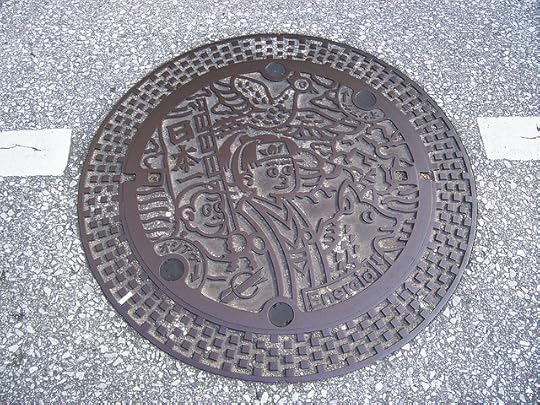
Momotaro manhole cover by married to potatoes, on Flickr
Their construction barricades are cute.

Adorable frogs!
Even their police boxes are adorable.

Koban is a Japanese police box and this one has a super kawaii mascot.
So it goes without saying that something so important to Japanese culture as their family crests are also amazing. And they’re everywhere in Japan.
On buildings.
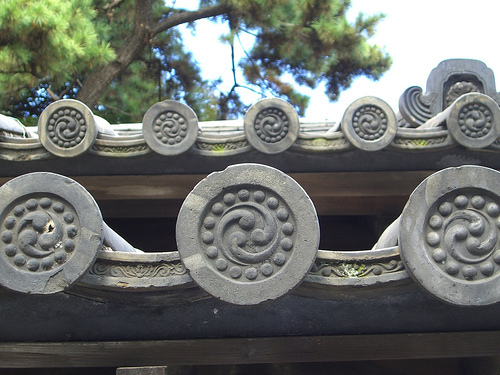
At the Imperial Palace in Tokyo.
Embedded into fences.

Minamoto Kamon: Sasarindo 笹竜胆
On noren curtains.

Purple noren curtain, Northern Japan
And stamped into metal plates.
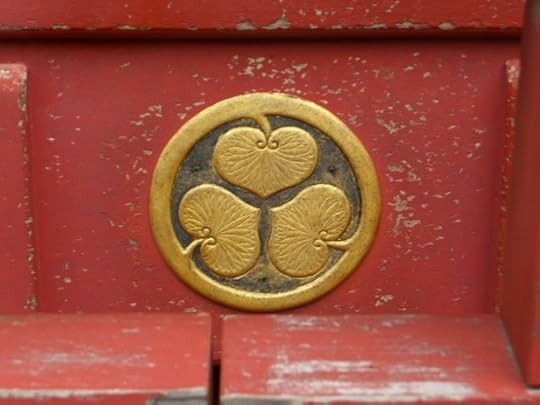
At a temple
So, now the little round emblem at the top of every chapter of REMOVED is starting to make sense, right? Yes, that’s the Sakai family kamon, and since REMOVED, Book 1, is centered around Sakai clan, their kamon represents Book 1 of the series! Who’s next? There’s a clue in the half title page of the print version of REMOVED. Did you buy the eBook? Here, it just so happens I designed the book so I can share it.

All the kamon used in the entire Nogiku Series. Sakai, Minamoto, Taira, Maeda. Then four mysteries! But if you google, you can figure them out.
If Sakai clan is the focus of REMOVED, Book 1, then I’m sure you can guess who will be in focus in Book 2  Book 4 is the only deviation from this scheme I present to you because many families become involved. Oh, I JUST LOVE HANDING OUT CLUES! I’m evil, I know.
Book 4 is the only deviation from this scheme I present to you because many families become involved. Oh, I JUST LOVE HANDING OUT CLUES! I’m evil, I know.
Haven’t bought REMOVED yet? You can purchase it on Amazon (Paperback) / Amazon (Kindle) / Barnes & Noble / Kobo
Don’t forget to enter the Goodreads Giveaway!
And the Super Awesome Japanese Bento Giveaway continues for two weeks!
September 17, 2013
The history of Japanese clans
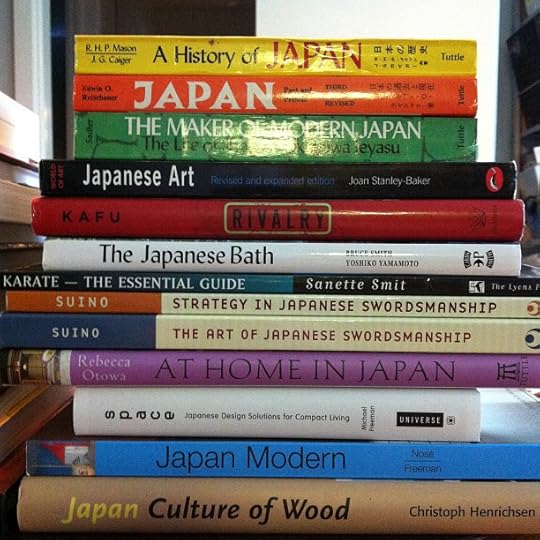
I take research for my books seriously. This is only 1/3 of the books I have on Japan.
REMOVED is filled with direct Japanese historical and cultural references that take an ordinary object or tradition and place it in a futuristic setting, renewing its significance and cementing the importance of an otherwise dying civilization.
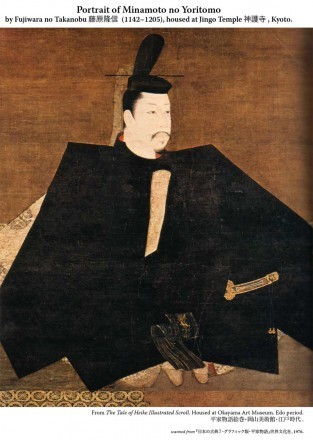
Minamoto no Yoritomo
Probably the most important of REMOVED‘s cultural references are the use of actual Japanese clans to represent the major families in Nishikyō. This has been my favorite part of writing the Nogiku Series! I love family traditions and feuds (Shakespeare captured my heart with the Capulets and Montagues).
Japan has four noble clans that are most directly related to the Emperor: Minamoto, Taira, Fujiwara, and Tachibana. Over many thousands of years, they have been the most important people in the country, vying for status, land, and rule over their sections of Japan. There are hundreds of other clans in Japan too, some major, some very small, but these four have always been at the top of the pyramid.
Minamoto and Taira, REMOVED’s biggest clans, are most well-known for their roles in THE TALE OF HEIKE, a work of historical fiction as popular in Japan as THE TALE OF GENJI. This 12th-century novel tells the story of a Japanese civil war, The Genpei War (1180-1185). This was a turbulent time in history for Japan, a time before the Shogun when each section of the country was in chaos as one prominent clan after another tried to successfully govern everyone.
The major players in The Genpei War were Taira (also known as the Heike Family) and Minamoto (also known as the Genji Family), and they being the largest families fought each other for rule over the country. Amongst the many notable events that occurred during this war, it was one of the first times that ninja spies were used! Minamoto employed them to gain information on Taira to his ultimate advantage.

Minamoto forces (on the right, with white banners) charge off-shore towards the Taira who have panicked and boarded their boats at Yashima.
Since The Genpei War, Minamoto and Taira have continued their back and forth fight with one another, though all the clans live peacefully now in Japan. The Fujiwara clan is the family that’s most directly related to the Japanese Emperor and his family. The two families have married between themselves many times. And the Tachibana clan has almost all but died out.
The other clans referenced in REMOVED, Sakai clan and Maeda clan, are smaller clans. Sakai clan is a direct descendent of both the Emperor and Minamoto clan and is considered a fudai “family” clan (as opposed to an “outsider” clan). In Japanese history, Sakai clan members were mostly retainers, teachers, and protectors as they are in REMOVED. Maeda clan is a smaller but powerful samurai clan that was chosen for REMOVED’s yakuza clan, but in Japanese history, these two have no affiliation. My use of them as yakuza is purely fiction.
With the introduction of clans/families into the story, Sanaa is both fascinating and repelled by their very nature. She is unwittingly involved in their actions and every move the clans make affect her eventual choices. REMOVED is just the beginning! The three clans I have introduced here are just a taste of what can be expected from all 4 books in the series.
If you’re interested in Japanese history or any of the other books I used for reference, please check out this blog post I did on research and immersing myself in Japanese traditions and culture.
Haven’t bought REMOVED yet? You can purchase it on Amazon (Paperback) / Amazon (Kindle) / Barnes & Noble / Kobo
Don’t forget to enter the Goodreads Giveaway!
And the Super Awesome Japanese Bento Giveaway continues for two weeks!
September 16, 2013
Launch day, Japanese food, and a giveaway!
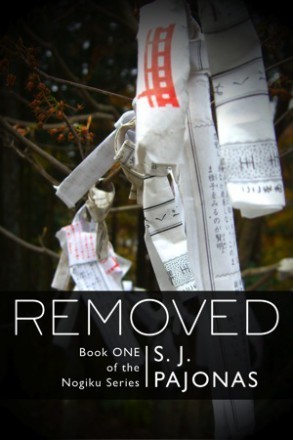
REMOVED on sale now!
This is it! The week my debut novel, REMOVED, Book ONE of the Nogiku Series, is available. If you haven’t purchased it, please do! You can find it on Amazon (Paperback and Kindle), Barnes & Noble, and Kobo. Putting my books in the hands of readers means the world to me. I’m hoping you’ll read and won’t be disappointed. Don’t forget to leave a review on your favorite site too! Amazon, Goodreads, BN, Shelfari, LibraryThing, your own blog, what have you. In November, I’ll be holding a “Reader Appreciation” Giveaway, and your review will get you a lot of slots!
To celebrate REMOVED‘s book birthday, I’m hosting a giveaway (more on that at the end of this post)! Japanese food and socializing are a huge part of REMOVED. Miko’s family izakaya, Izakaya Tanaka, is a Japanese version of an English pub. Izakayas in Japan are usually small, seating anywhere from only 10 to 50 people. Beer and sake along with a large menu of grilled or fried food (sometimes there are sushi bars within the izakaya) are served and patrons tend to stay for long periods of time. It’s not uncommon for Japanese citizens to have a favorite, secret izakaya that they frequent often. They know the owner and the owner knows them. Patrons can even guarantee a seat if they are well-loved. (This is a dream of mine, of course). In REMOVED, Sanaa and her friends spent their nights and weekends growing up at Izakaya Tanaka. It’s a central part of their lives.

A super oishii sushi meal but sushi is just the tip of Japanese cuisine.
Westerners tend to think that sushi is the end-all be-all of Japanese food, but that couldn’t be further from the reality. Ramen, tempura, rice and seaweed, miso soup, and pickles are also some of the Japanese food most often eaten by Sanaa and her friends, and those items are just skimming the surface of the Japanese diet. When they aren’t at Izakaya Tanaka, they are visiting ramen or udon (udonya) restaurants, shopping at the local grocery store, or picking up food from the ward cafeteria. Conversations, parties, and dates are all held over meals. Food is an integral part of the story. (So are good drinks, like sake. Check out my post on sake from October!)
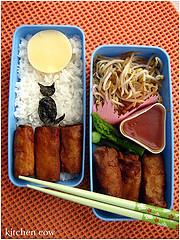
Isn’t this adorable? Bento 149: Lumpiang Shanghai Over the Moon! from Kaoko on Flickr
One of the things I particularly love about Japan are bentos! Bento boxes are the equivalent of a packed lunch. The boxes themselves come in all shapes and sizes, some with compartments or little plastic lidded containers to hold a multitude of food. Bento boxes can be utilitarian or they can be fun! I’m dying to own a really cute Hello Kitty bento box with matching chopsticks. Collecting bento boxes could easily be an obsession of mine. I really need to stay away from ebay.
In general, a bento lunch will have at least 3 items but most likely more. Noodles or rice, salad, fish or meat, vegetables, dumplings, sushi… The variety is staggering. A well-prepared meal by mom or a significant other conveys their love to you through food. What’s better than that? If you need some bento inspiration, I highly recommend this search for “bento” on Flickr. You’ll see tons of great lunches and bento accessories to help you create a visually appealing meal as well.
Sanaa gets takeout bento boxes for breakfast all the time in REMOVED. She’s someone who is always on the go and needs a quick meal she can eat before work. In Japan, takeout bentos are regularly accessible pretty much everywhere from the train station platform to the local 7-11. Takeout bentos and sushi are fast food! Sure, McDonald’s and its brethren are available, but bentos and sushi were the original fast food, small items that can be eaten quickly, even by hand! Unless you’re in a fancy restaurant, it’s okay to eat sushi with your fingers. I swear 
Now that REMOVED is available for purchase I have two giveaways you can participate in!
First is the easiest giveaway ever. If you’re a Goodreads member, you just click a button on the Goodreads website to be entered to win one of two signed copies. Easy peasy.
Goodreads Book Giveaway

Removed
by S.J. Pajonas
Giveaway ends October 01, 2013.
See the giveaway details
at Goodreads.
And here is the really big giveaway! Use the Rafflecopter signup below, and you’ll be eligible for one of 3 prize packages (U.S. Residents only)!
Check this out: your very own super kawaii bento box, onigiri (rice ball) mold, and adorable food picks, plus a signed copy of REMOVED.
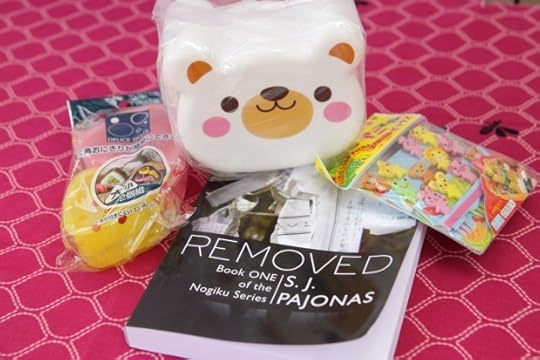
Giveaway prizes!! Aren’t they fabulous?
Contest goes on for two weeks! And you can come back everyday and tweet about it again for another entry. Ganbatte minnasan!
September 12, 2013
REMOVED is available now!
I broke my own street date unintentionally!
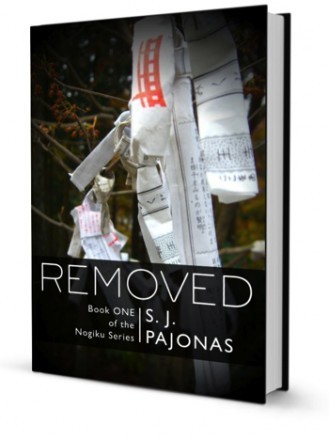 REMOVED is available online right now!
REMOVED is available online right now!
I hadn’t intended on the book being available early. Every place I uploaded to gave me windows of 3-5 business days, so I thought, “I’ll upload Tuesday and Wednesday before the Monday that I promised and hopefully the book will be available.” I had heard stories of BN taking up to TEN business days to approve a book, so I wanted to be cautious. Well, everything was available as of last night. Oops!
Amazon (Paperback): http://amzn.com/1940599032
Amazon (Kindle): http://amzn.com/B00F4IE978
Barnes & Noble: http://www.barnesandnoble.com/s/2940148646532
Kobo: http://store.kobobooks.com/en-US/ebook/removed
So get your copy and you’ll have something to read over the weekend!
This is only the beginning of this journey, my friends. I have more books to publish in this series. First the guaranteed FOUR. Then I have plans for a companion novella, prequels and sequels. And I have a contemporary romance I’m working on as well.
I hope you all enjoy these books! I look forward to giving you plenty to read in the future.
Come back Monday, September 16 through Friday, September 20th, for an awesome Japanese food inspired giveaway and many posts on Japanese cultures and traditions that I drew upon to write REMOVED. They’re informative and fun. I’m sure you’ll love them.
September 9, 2013
New Year’s Eve
REMOVED opens on New Year’s Eve, an auspicious and exciting time of year for the Japanese, and Sanaa spends the evening with Miko and Helena, like she does every year, at Izakaya Tanaka. But this New Year’s Eve is unlike any other. New Year’s Eve 3103 is her first encounter with Jiro and his presence inspires her to wish for love and excitement instead of prosperity. Little does she know she’s about to get more than she bargained for. Her whole life changes less than two days later, and before she understands where her new path is taking her, she’s swept up into secrets, lies, intrigue, and danger at the hands of the clans of Nishikyō.

Sanaa and Miko with their omikuji on New Year’s Eve
This is the last of the teaser images for REMOVED! Please feel free to share this image and spread it around! It will also be on Twitter, Facebook, and Tumblr by the end of the day.
Only 1 more week until REMOVED is available! Don’t forget to queue REMOVED on Goodreads!



